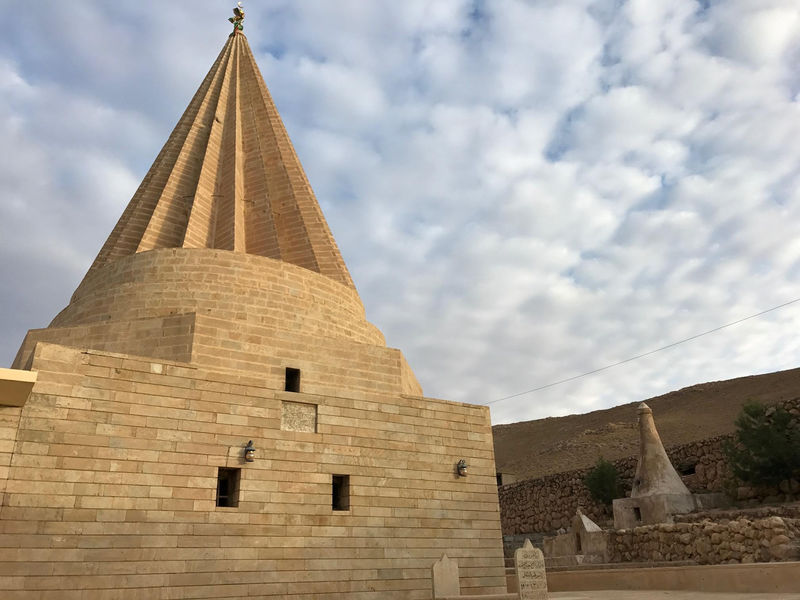 © Reuters. The Sharaf al-Din shrine is seen in the city of Sinjar
© Reuters. The Sharaf al-Din shrine is seen in the city of SinjarBy Raya Jalabi
SINJAR, Iraq (Reuters) – Since Iraqi forces pushed the Kurds out of the Yazidis’ mountainous heartland of Sinjar in northern Iraq in October, residents are wondering what could happen to them next.
Food and money are in short supply since aid organizations stopped delivery after Iraq’s advance. Buildings collapsed in the fighting and of those still standing, many are marked with bullets and littered with IEDs. Water and electricity barely work.
The Yazidis, whose beliefs combine elements of several ancient Middle Eastern religions, have long been viewed with suspicion and repeatedly persecuted by other groups in Iraq.
In 2014, more than 3,000 were killed by Islamic State militants in a campaign described by the United Nations as genocidal.
Now the land they have lived on for centuries is caught up in a tug of war between Baghdad and Iraq’s Kurds, who had controlled it since the fall of Saddam Hussein in 2003.
“We’re trapped in this game of political football, between Iraq and the Kurds,” said a Yazidi resident of Sinjar, Kamal Ali. “But neither of them cares about our future.”
The militias have hoisted Iraq’s tricolor flag over government buildings and any remaining Kurdish flags have been scrawled over with the words “Iraq” and “Allahu Akbar”, the blazing sun at its center scribbled over in black marker.
Sinjar is politically important because it’s in the disputed territories, ethnically mixed areas across northern Iraq, long the subject of a constitutional dispute between Baghdad and the Kurds, who both claim them.
Sinjar fell under the Kurds’ control, despite lying outside Iraqi Kurdistan’s recognized borders.
Baghdad did little to challenge the arrangement until its October offensive, launched to punish the Kurds for their Sept. 25 independence referendum. Iraqi forces have seized the disputed areas the Kurds had expanded into including Sinjar.
The referendum reignited long-simmering tensions over geographic dominance in the oil-rich north, between Baghdad and the Kurdish Regional Government (KRG), who fought side by side to defeat Islamic State.
DIVIDED
The Yazidis are divided about what should happen now.
Some are glad the Kurds have gone and see an opportunity for increased autonomy now that they are under federal control following the offensive by Iraq’s security forces last October. Kurdish forces handed over Sinjar without a fight to the Lalesh Brigades, a Yazidi militia backed by Baghdad’s Shiite paramilitary forces (PMF).
Most Yazidis speak a Kurdish dialect, but many don’t see themselves as ethnically Kurdish.
“We’re happy the Kurds have left,” said Abu Sardar, a 47-year-old Yazidi man. “We’re Yazidis we’re not Kurds, we do not want to be part of Kurdistan.”
Like others, Abu Sardar complained that the Kurds forced him to vote in the Kurdish referendum, accusations the KRG denies.
He returned two months ago to the ruins of his home in the Sinuni district of Sinjar and expressed bitter disappointment that little had changed since he left in 2014: hospitals and schools remain shuttered while the city is still mostly rubble.
He hopes that Baghdad and its militias will rebuild Sinjar.
Others lament the Kurds’ departure.
The KRG and allied Yazidi groups hold former Iraqi Prime Minister Nuri al-Maliki responsible for the campaign by Islamic State. They say his troops’ desertion of Mosul allowed militants to capture billions of dollars in weapons later used to attack the minority.
Yazidi commander Qassem Shesho says Iraq’s government is too sectarian and dislikes the Yazidis as much as Islamic State.
Like many others, he blames the Kurds for the attack by Islamic State.
“But they’re all we’ve got,” he said.
Shesho is allied to Iraqi Kurdistan’s ruling Kurdistan Democratic Party, even though the Kurds cut his fighters’ salaries after the Lalesh Brigades took over Sinjar.
‘CITY OF GHOSTS’
Some days, residents say, there are only bones in Sinjar. Nearly 50 mass graves have been uncovered outside the town since 2014.
“Sinjar is a city of ghosts,” said the Lalesh Brigades’ leader Ali Serhan Eissa, also known as Khal Ali.
Tens of thousands of Yazidis fled the militant onslaught and headed for Mount Sinjar. Of those who didn’t reach the mountain, about 3,100 were killed – with more than half shot, beheaded, burned alive and disposed of in mass graves.
Others were sold into sexual slavery or forced to fight, according to a report by the Public Library of Science journal PLoS Medicine.
Some are still on the mountain, about to spend a third freezing winter in tents.
Before the attack, Sinjar was home to about 400,000 people – mainly Yazidis and Arab Sunnis. Only 15 percent of Yazidis have returned home, according to humanitarian estimates.
Most Yazidis remain in IDP camps in the Kurdistan region, along with most of the area’s displace Sunnis. Aid workers worry the camps will be closed if tensions between Baghdad and the Kurds flare up.
The presence of fighters from Turkey’s separatist Kurdistan Workers Party (PKK) further complicates the picture. Many Yazidis credit them with opening up a land route to allow those stranded on Mount Sinjar to escape the militants in 2014.
The PKK entrenched itself in the community, even creating a local unit, the Sinjar Resistance Units (YBS) which controls multiple checkpoints around Sinjar.
Turkey and neighboring Iran are closely watching the power shift in Sinjar.
Tehran wants to secure this north-western region of Iraq as it sits on the border with Syria, while Turkey wants the region free of the outlawed PKK.
Source: Investing.com





























